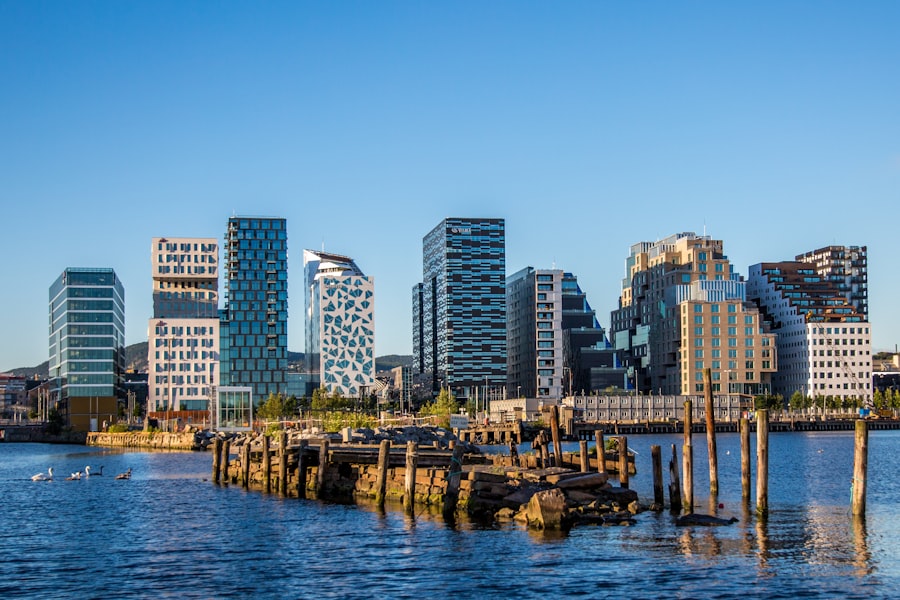Fårikålsesong, or the “Fårikål season,” is a cherished time in Norway that celebrates the country’s national dish, fårikål. This hearty lamb and cabbage stew is traditionally enjoyed during the autumn months, particularly in September and October, when the ingredients are at their freshest. The season is marked by a collective enthusiasm for this comforting dish, as families and friends gather to share meals that evoke a sense of nostalgia and cultural pride.
Fårikålsesong is not merely about the food; it embodies a sense of community and tradition that resonates deeply within Norwegian society. During this time, many Norwegians partake in the ritual of preparing and enjoying fårikål, often sharing recipes passed down through generations. The dish itself is simple yet satisfying, consisting primarily of lamb, cabbage, and whole black peppercorns, all simmered together to create a rich and flavourful stew.
As the leaves change colour and the air turns crisp, the arrival of fårikålsesong signals a time for warmth, comfort, and connection to one’s roots. Schedule a one-on-one consultation with our relocation specialists to simplify your move to Norway.
Summary
- Fårikålsesong is the Norwegian tradition of celebrating the autumn season by cooking and enjoying Fårikål, a traditional lamb and cabbage stew.
- The history of Fårikål dates back to the 1700s and is believed to have originated from the need to preserve meat and vegetables during the long winter months in Norway.
- Traditional Fårikål ingredients include lamb, cabbage, peppercorns, and water, and it is typically cooked in a large pot for several hours to develop its rich and hearty flavour.
- Regional variations of Fårikål exist across Norway, with different regions adding their own unique twist to the classic recipe, such as using different spices or vegetables.
- Fårikålsesong holds significant cultural importance in Norway, bringing people together to celebrate the harvest season and enjoy a comforting and traditional dish.
The History of Fårikål
The origins of fårikål can be traced back to the 18th century, making it one of Norway’s oldest traditional dishes. Historical records suggest that it was first mentioned in a cookbook published in 1866, although it likely existed long before that. The dish reflects Norway’s agrarian past, where sheep farming was prevalent, and cabbage was a staple crop.
Fårikål was born out of necessity, utilising readily available ingredients to create a nourishing meal that could sustain families through the harsh winters. Over the years, fårikål has evolved from a simple peasant dish to a symbol of national identity. In 1972, it was officially designated as Norway’s national dish, further solidifying its place in the hearts of Norwegians.
The dish has become synonymous with autumn celebrations and family gatherings, serving as a reminder of the country’s rich culinary heritage. As Norway continues to modernise, the historical significance of fårikål remains intact, connecting contemporary society with its agricultural roots.
Traditional Ingredients and Cooking Methods

At its core, fårikål consists of just three primary ingredients: lamb, cabbage, and whole black peppercorns. The choice of lamb is crucial; traditionally, it is made with mutton or young lamb, which imparts a distinct flavour to the stew. The cabbage used is typically green cabbage, which holds up well during the long cooking process and adds a subtle sweetness to the dish.
Whole black peppercorns are added for seasoning, providing warmth and depth to the overall flavour profile. The cooking method for fårikål is straightforward yet requires patience. The lamb is first cut into pieces and layered with cabbage in a large pot.
Whole peppercorns are sprinkled throughout, and water is added to cover the ingredients. The pot is then brought to a gentle simmer and left to cook for several hours. This slow-cooking method allows the flavours to meld beautifully while ensuring that the meat becomes tender and succulent.
Traditionally served with boiled potatoes on the side, fårikål is a dish that embodies simplicity and comfort.
Regional Variations of Fårikål
While the basic recipe for fårikål remains consistent across Norway, regional variations do exist that reflect local tastes and traditions. In some areas, for instance, cooks may choose to add root vegetables such as carrots or turnips to enhance the stew’s flavour and nutritional value. Others might incorporate different herbs or spices to give their version a unique twist.
These variations often arise from local customs or available ingredients, showcasing the adaptability of this beloved dish. In addition to ingredient variations, cooking methods may also differ from region to region. Some families prefer to use a pressure cooker for a quicker preparation time, while others adhere strictly to the traditional slow-cooking method.
Regardless of these differences, each version of fårikål retains its essence as a comforting meal that brings people together during the colder months.
The Significance of Fårikålsesong in Norwegian Culture
Fårikålsesong holds profound significance in Norwegian culture beyond its culinary appeal. It represents a time for families to come together and celebrate their heritage through food. The act of preparing and sharing this dish fosters connections among generations, as recipes are passed down and stories are shared around the dinner table.
This communal aspect of eating is deeply ingrained in Norwegian culture, where meals are often seen as an opportunity for bonding and reflection. Moreover, fårikålsesong serves as a reminder of Norway’s agricultural roots and the importance of seasonal eating. As Norwegians embrace locally sourced ingredients during this time, they honour their connection to the land and its bounty.
This celebration of traditional food not only preserves cultural identity but also reinforces community ties as people gather to enjoy a meal that has been cherished for centuries.
How to Celebrate Fårikålsesong in Norway

Celebrating fårikålsesong in Norway can take many forms, from intimate family dinners to larger community gatherings. One popular way to mark the occasion is by hosting a fårikål dinner party where friends and family come together to enjoy this beloved dish. Guests can contribute by bringing their own variations or side dishes, creating a festive atmosphere filled with laughter and shared experiences.
In addition to home celebrations, many towns and cities across Norway organise events dedicated to fårikålsesong. These gatherings often feature cooking demonstrations, tastings, and even competitions where participants showcase their best versions of the dish. Such events not only promote culinary creativity but also foster a sense of community pride as locals come together to celebrate their shared heritage.
Pairing Fårikål with Norwegian Beverages
To enhance the experience of enjoying fårikål, pairing it with traditional Norwegian beverages can elevate the meal further. A classic choice is aquavit, a flavoured spirit that is often enjoyed alongside hearty dishes like fårikål. Its herbal notes complement the rich flavours of the stew while providing a refreshing contrast.
For those who prefer non-alcoholic options, locally brewed apple cider or berry juices can serve as delightful accompaniments. These beverages not only reflect Norway’s agricultural bounty but also add a touch of sweetness that balances the savoury elements of the dish. Ultimately, selecting beverages that resonate with local flavours can enhance the overall dining experience during this special season.
Fårikål Recipes for the Home Cook
For those eager to try their hand at making fårikål at home, several recipes cater to different tastes and preferences. A traditional recipe typically involves layering pieces of lamb with cabbage in a large pot, seasoning with whole black peppercorns, and simmering until tender. However, variations can include adding root vegetables or herbs for added depth.
For a modern twist on this classic dish, some cooks experiment with different cuts of meat or even vegetarian alternatives using mushrooms or jackfruit as substitutes for lamb. These adaptations allow for creativity while still honouring the essence of fårikål as a comforting autumn meal.
Fårikålsesong Festivals and Events
Throughout Norway, various festivals celebrate fårikålsesong, drawing locals and tourists alike to partake in this culinary tradition. One notable event is “Fårikålens Festdag,” celebrated on the last Thursday in September each year. This day encourages Norwegians to prepare and enjoy fårikål while sharing their experiences on social media platforms using dedicated hashtags.
In addition to this national celebration, many regions host their own festivals featuring cooking competitions, tastings, and cultural performances centred around fårikål. These events not only highlight the dish’s significance but also promote local produce and foster community spirit through shared culinary experiences.
Fårikål in Modern Norwegian Cuisine
As Norwegian cuisine continues to evolve, fårikål remains a beloved staple while also finding its place in modern culinary trends. Chefs across the country are reinterpreting this traditional dish by incorporating contemporary techniques or fusion elements that reflect global influences. For instance, some restaurants may serve fårikål with innovative sides or garnishes that elevate its presentation while maintaining its comforting essence.
Despite these modern adaptations, the heart of fårikål remains unchanged—a celebration of simplicity and flavour that resonates with both locals and visitors alike. This enduring appeal ensures that even as culinary trends shift, fårikål will always hold a special place in Norwegian hearts.
Fårikål in the Context of Sustainable and Local Food Movements
In recent years, there has been a growing emphasis on sustainability within food movements worldwide, and Norway is no exception. Fårikål aligns perfectly with these principles as it utilises locally sourced ingredients that reflect seasonal availability. By celebrating this traditional dish during its designated season, Norwegians actively support local farmers and promote sustainable agricultural practices.
Moreover, preparing fårikål at home encourages mindful eating habits by prioritising fresh produce over processed foods. As more people seek to reconnect with their food sources and embrace seasonal eating, fårikål serves as an exemplary model of how traditional dishes can contribute positively to both personal health and environmental sustainability. In conclusion, Fårikålsesong is more than just a culinary celebration; it encapsulates Norway’s rich cultural heritage while fostering community connections through shared meals.
As families gather around steaming pots of this beloved stew during autumn months, they honour traditions that have stood the test of time while embracing modern interpretations that keep the spirit alive for future generations. For those looking to immerse themselves further into Norwegian culture during this season or even consider relocating to Norway for an extended stay or permanent move, organisations like the Norway Relocation Group can provide invaluable assistance in navigating this transition smoothly. As you settle into your new life in Norway, consider enrolling in Norwegian courses at the NLS Norwegian Language School in Oslo.
These courses will not only help you learn the language but also deepen your understanding of Norwegian culture—making your experience during Fårikålsesong all the more enriching as you engage with locals over this cherished dish!
Register for a Norwegian class at the NLS Norwegian Language School now!

